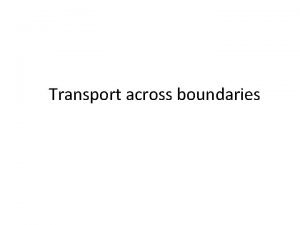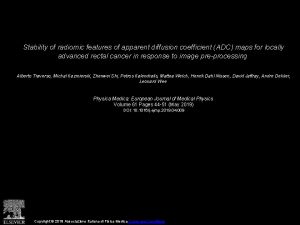Technical Factors affecting Apparent Diffusion Coefficient in Women




- Slides: 4

Technical Factors affecting Apparent Diffusion Coefficient in Women with Locally Advanced Cervical Cancer Gladwish, Abstract #3708 – Goal: To measure ADC variability resulting from technical acquisition differences for women with local advanced cervical cancer – Inconsistency in ADC reporting between institutions may depend on b-value selection, field strength, and vendor. • Low cervical tumor ADC value has been linked to both increased and decreased diseasefree survival in the literature (Nakamura et al, Gyn Onc 2012; Heo et al, KJR 2013) B-value selection problem - Rapid decay at low b (perfusion) Log (DWI) - Monoexponential decay at intermediate b - Non-linear decay at high b (less/more watery tissue spaces) - Noise floor at high b Thoeny et al, JMRI 2012

Technical Factors affecting Apparent Diffusion Coefficient in Women with Locally Advanced Cervical Cancer Gladwish, Abstract #3708 – Methods • Eighty patients with locally advanced cervical cancer with baseline DWI-MRI imaging • Four data sets with 2 b-value combinations and field strengths • DWI signal extraction from cervix tumor, urine, and skeletal muscle to test: 1. Tumor ADC model accuracy (mono-exponential decay) 2. Tumor ADC variability between DWI acquisition parameters, with and without normalization to urine. 3. External validation to a published histologic classifier

Technical Factors affecting Apparent Diffusion Coefficient in Women with Locally Advanced Cervical Cancer Gladwish, Abstract #3708 • ADC Modelling – R 2 for monoexponential fitting was 0. 86 to 0. 96 for tumors, and 0. 99 to 1. 00 for urine – Equivalent ADC between protocols 1, 2, and 4, but reduced for protocol 3 (3. 0 T, 4 b) likely because of inadequate fat suppression. • ADC Variability – Tumor had lowest CV (40% of patients within 15% of mean) – Urine had highest CV (85% of patients within 15% of mean) – 55% of patients within 15% of mean with normalization of tumor to urine ADC • External Validation – Sensitivity/Specificity for histologic classification increased from 27 and 80% to 60 and 89% with normalization to urine ADC. Table 1 – CV and R 2 by ROI and DWI acquisition Table 2 ADC by field strength and b-value

Technical Factors affecting Apparent Diffusion Coefficient in Women with Locally Advanced Cervical Cancer Gladwish, Abstract #3708 • Summary 1. Pooling of DWI-MRI data across studies is feasible based on the mono-exponential decay model for field strengths of 1. 5 – 3. 0 T and for b-values up to 1000 s/mm 2. ADC appears to be largely independent of b-value and field strength, but care must be taken to ensure proper fat suppression. 3. Utilization of urine as an internal reference structure improved variability and performance of an internal classifier. This strategy may strengthen future comparisons of cross-institutional ADC measurements.






